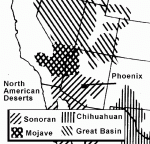Urbanization of the arid regions of the western and southwestern U.S. is a comparatively recent phenomenon with meteoric expansion largely coming after World War II. Arizona has been identified as the second fastest growing state in the nation for the past six years, with Phoenix its capital and the largest city in the Southwest. The Phoenix metropolitan area’s spectacular growth in population -- doubling twice in the past 35 years -- and its rapid and continuing expansion into former agricultural and pristine settings provides a unique opportunity to monitor human-induced ecological transformations, resulting from rapid land-use transformations.
Arizona is a state of diverse local climates and closely juxtaposed life zones, with at least five major vegetation communities existing within the CAP boundaries. Moreover, central Arizona stands astride major geographic and climatic transition zones between the Sonoran and Chihuahuan Deserts, the Sierra and Rocky Mountain ranges, and weather patterns dominated by the Pacific Ocean as well as the Gulf of Mexico. With less than seven inches of annual rainfall, Phoenix is situated in a truly arid landscape with concomitant reliance on surface or groundwater, a high moisture evaporation rate, and continual threat of desertification. That these same issues are faced by those living on a one-third of the world’s land surface makes the relationships examined in this LTER relevant to people around the globe.
Historic patterns of growth in the central Arizona-Phoenix region will be reconstructed by using maps, planning documents, aerial photographs, and satellite imagery to generate a record of urban change. Computer modeling will be centered on a hierarchical, spatially explicit, patch dynamic approach. Land-use patches include parks, open space, native vegetation, and residential, commercial, and industrial categories. At intermediate scales, landscape models will be developed to determine the effects of multiple patches. A regional simulation model of the entire area will be developed to predict and test the ecological consequences of alternative patterns of future development.
Patch-specific ecological characteristics will be monitored in five core categories: primary production, natural population and community characteristics, storage and dynamics of organic matter, movement of materials (including water) and patterns of disturbance that occur through redevelopment, fire, or flood. Furthermore, patch types will be compared from city center toward the outer fringe, permitting data collection and analysis intended for land-use planning.
The CAP LTER will have a unique opportunity to investigate the relationship between land-use decisions and ecological consequences in an urban environment.
Finally, the CAP LTER has an explicit commitment to engage the broader Phoenix community, both in K-12 education and the general public’s understanding of science. Students will participate in data collection both directly and remotely. Teachers will be provided with curriculum tools and activities to increase opportunities for the entire classroom to engage in an active scientific experiment. Partnerships with Phoenix community groups will allow informal science education to occur regardless of the age of the resident.
The key objectives for the CAP LTER are to generate and test ecological theory in an urban environment; enhance the understanding of the ecology of cities; identify the interrelationships between ecological and socioeconomic factors; collect and make available a tremendous corpus of reliable scientific information for use by scholars, policymakers, and the greater public; and engage the general public, especially K-12 students, in the process of scientific discovery.
The CAP LTER will involve dozens of scientists from six colleges at ASU Main, as well as ASU West and Maricopa Community College District. The Project Directors of the CAP LTER are Charles Redman, Director of the Center for Environmental Studies and Nancy Grimm, Associate Professor, Department of Biology. Strategic partnerships with more than 20 community organizations, agencies, and municipalities will provide opportunities for the entire region to contribute to and benefit from the long-term research associated with this exciting program.
The Central Arizona -- Phoenix LTER http://caplter.asu.edu/
Center for Environmental Studies http://www.asu.edu/ces
P.O. Box 873211
Arizona State University
Tempe, AZ 85287-3211
Phone: 602 965-0870

 Enlarge this image
Enlarge this image
